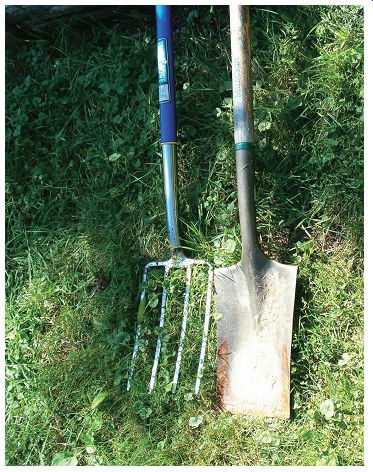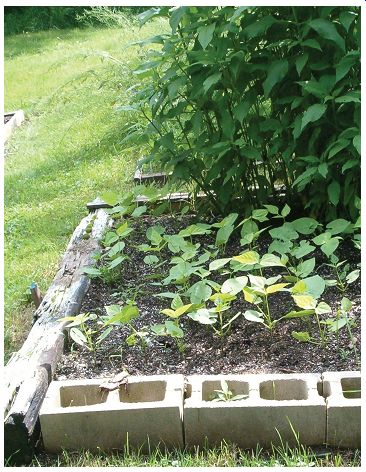Home food production is an important proficiency that contributes positively
to the physical and financial health of the family. Along with this, it provides
an important psychological and spiritual boost by reaffirming our connection
with nature and nature's laws, reconnecting us with our ancestral roots, and
providing the feeling of competence that comes from ensuring the supply of
a basic necessity--food.
Just as important, the quality of food produced at home is superior to that available in the supermarket for a number of reasons. The demands of business drive many factors that decrease the nutritional value of commercial foods. Because very little food is produced near its point of use, fruit and vegetable varieties are selected on the basis of suitability for machine picking, long-distance shipping, and cold storage so that they still look good when they reach the supermarket. This results in homogeneous and visually appealing products that look better than they taste and have considerably less nutritional value than homegrown equivalents.
Spinach is a good example. With proper care and refrigeration, fresh spinach can be kept from spoiling for three weeks or more.
But even when kept in the dark at 39 degrees, it loses about half of its B vitamin content in only a week. So the appealing bag of baby spinach under the brightly lit cooler in the supermarket actually has fewer nutrients than homegrown spinach that is blanched and frozen on the same day as harvest.
The same situation applies to other fruits and vegetables.
Considering the time spent in packaging, shipment, and storage, homegrown produce that is canned, frozen, or dehydrated quickly after harvesting will pack more nutritional punch than even so-called fresh produce at the supermarket.
Nutrient density is not the only factor favoring home food production. Pesticide residue is another important consideration.



Corporate farms and orchards use a variety of pesticides to protect the quantity and visual appeal of their harvests. According to a 1999 Consumer's Union report based on U.S. government data,
"An apple grown in the U.S. typically contains four pesticides, and some have as many as 10 different residues. " The same report listed several common vegetables, including winter squash and spinach, as typically containing residues of multiple pesticides, some with as many as 14. The report goes on to cite data indicating both widespread illegal pesticide usage and persistence of carcinogenic chemicals that were banned decades ago in present-day corporate harvests.
In addition, small home gardens are ideally suited to the use of organic or semiorganic materials and methods that can significantly reduce, and even eliminate, the need for synthetic pesticides.
Regardless, if a home gardener decides to use commonly available over-the-counter pesticides, proper usage and scheduling is personally ensured by the gardener to make sure that the amount of residue remaining in the food is far less than in typical commercially grown produce.
Superior taste is a major benefit to homegrown foods. The two major factors influencing taste are freshness and the actual variety grown. With a backyard garden, it is not unusual to serve vine ripened tomatoes within minutes of picking them from the vine, whereas supermarket tomatoes are harvested while green and allowed to ripen during shipment. It is really impossible for any sort of food store to exceed the degree of freshness found in a backyard garden.
In addition, because the vegetable varieties used in corporate agriculture (a.k.a. "agribusiness") are selected for toughness in shipping, simultaneous ripening, and ease of mechanical harvesting, some of the best-tasting varieties of numerous fruits and vegetables are not even available in supermarkets because they aren't suitable for machine picking or bruise too easily. Conversely, the home gardener is free to choose from literally thousands of common and/or heirloom varieties on the basis of personal taste.
Commercial growers are in business. As a result, the dollar is their standard of value. Your health-to the extent it even crosses their minds-is a far secondary concern. Their primary aim is the production of goods with the lowest possible cost and selling them at the highest possible price consistent with the greatest profit.
There is nothing automatically evil about this process, but it is obvious that the effort you can invest in making sure your food is safe, tasty, and healthful is far superior to that of a corporation half a continent away.
Finally, economy is an important reason to produce and preserve foods at home. The mini-farming methods covered in this book yield fresh produce at mere percentages of the cost of purchasing similar foods at the supermarket. This means that growing your own food can add precious dollars to the family budget, while preserving your own food can guarantee a supply of healthful food during lean times. Moving from vegetable gardening into full-scale mini-farming using intensive techniques can conceivably provide over 80% of a family's food, reducing cash needs by many thousands of dollars yearly.
We have met many people who used to grow gardens but have since abandoned the practice. While the details vary, in all of these cases the former gardeners had encountered conditions that made the realization of their gardening goals either impossible or impractical. Many had moved to homes with very small yards, so a traditional garden wouldn't fit. Some had experienced injuries that limited mobility. Others had encountered bad insect or other pest problems. Finally, many just gave up because gardening was too much time and trouble when compared to the benefits they derived.
The lesson we have learned is that people need to have a reasonable prospect of achieving their goals in gardening, or they won't bother.
The goals of the mini-farmer are similar to those of the home gardener but with an added emphasis on economics. The mini farmer's aim is to reduce the amount of income needed by providing a substantial portion of the household's food needs. This can allow a parent to stay at home with children, make homeschooling feasible, improve conditions under a fixed income, or act as a buffer against uncertain economic conditions.
In the sections ahead, we intend to demonstrate how the goals of gardening and mini-farming can be achieved with greater enjoyment and much less time, effort, money, and equipment than you ever expected, in spite of whatever obstacles may arise.
The approaches adopted in this guide are a combination of traditional, Biodynamic, Grow Bio-intensive, French Intensive, Square Foot, and other approaches that use raised beds and that we call "intensive agriculture. " It stands on the shoulders of many great and dedicated gardeners, thinkers, philosophers, and farmers, so we claim no unique credit for it, but the synthesis has been made based on my own experience and will hopefully save the reader a lot of trial and error.
The content of this guide can be used at various levels. It can be used to allow efficient hobby gardening for improved nutrition and enjoyment, a more substantial commitment to gardening, and full fledged mini-farming. My aim, then, is to help the reader get started on a path to growing more economical, nutritious, and safe food with minimal effort while simultaneously helping the reader reconnect with the cycles of nature and heritage in a way that will enhance the spirit.